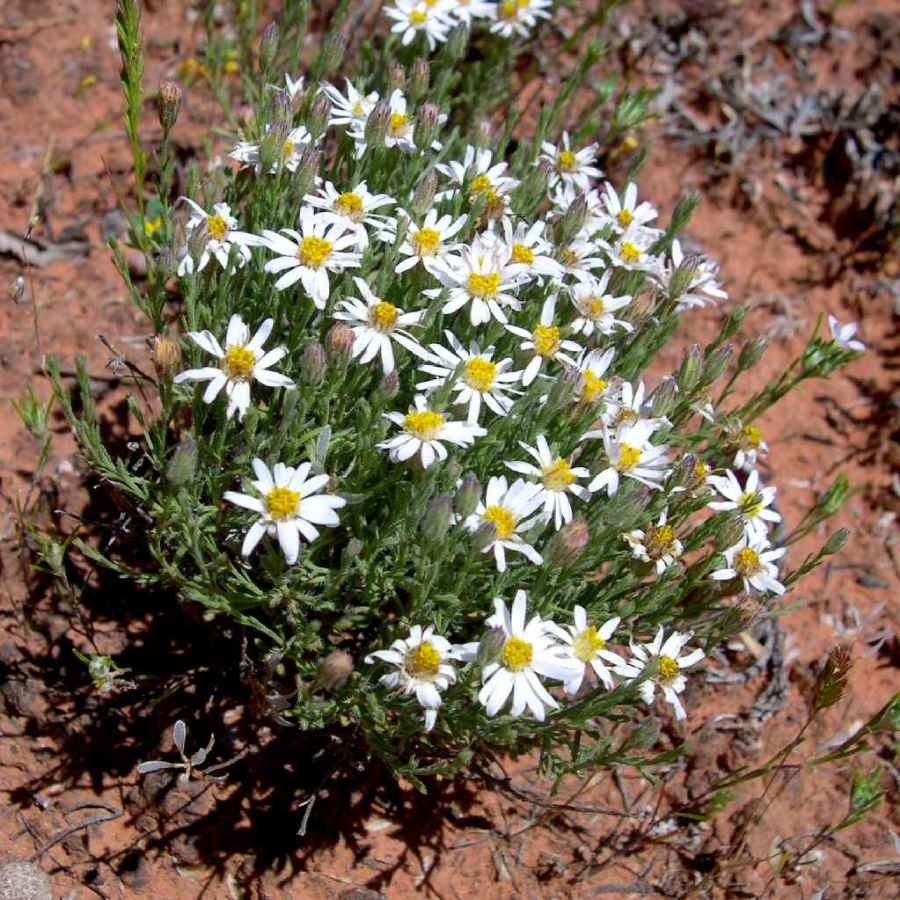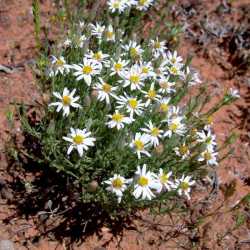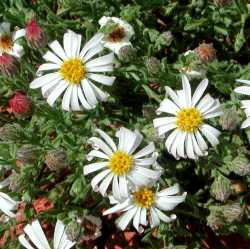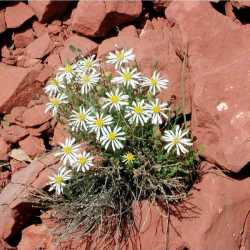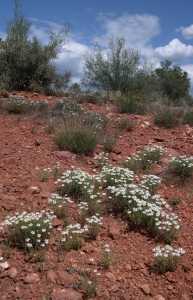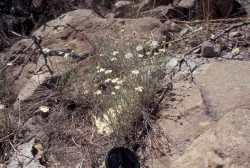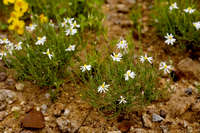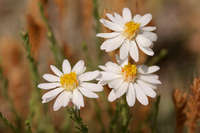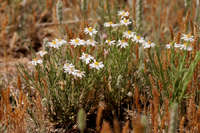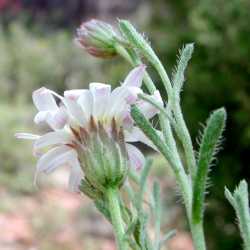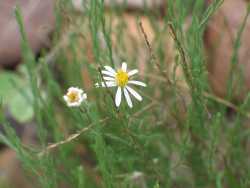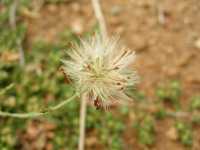Perennials, 6-12 cm, densely stipitate-glandular or eglandular; taprooted (usually not evident in collections), forming beds or clumps of large, separate tufts connected by underground rhizomes and caudexlike, scaly-leaved stems. Leaves even-sized, densely overlapping; blades linear-oblanceolate to lanceolate, 5-11(-20) × 0.5-2 mm, coriaceous, bases not clasping (midnerves strongly raised, longitudinally 2-grooved adaxially), apices spinulose, faces usually densely, minutely, orangish stipitate-glandular. Involucres turbinate to hemispheric, (3.5-)4.5-6(-7) × 4-8 mm. Ray florets (8-)12-24; corollas white. Disc florets 12-24, bisexual. Cypselae 1.7-3 mm, 5-nerved, faces strigose; pappi of (20-)24-26(-30) barbellate bristles in 1 series. 2n = 16, 32.
Flowering (Mar-)Apr-Aug(-Nov). Open sites over shale, gypsum, igneous, limestone, roadsides, grassland, Larrea flats, juniper to pinyon-juniper woodlands; 600-2300 m; Ariz., Calif., Colo., Kans., Nebr., Nev., N.Mex., Okla., Tex., Utah, Wyo.; Mexico.
Chaetopappa ericoides is widespread and highly variable in the type and amount of pubescence as well as other features. Of 34 chromosome counts made from Arizona, New Mexico, Texas, and Chihuahua by D. E. Ward and R. Spellenberg (1986), all but two were tetraploid (2n = 32). L. H. Shinners (1946b) noted that the late-season forms are taller with narrower, less hairy leaves, narrower and fewer-flowered heads, and shorter ligules. Some plants lack the dense vestiture of stipitate glands; there does not appear to be a clear geographic pattern to the occurrence of such plants. Shinners also noted that a variant form in northern Mexico with fewer, more widely spaced leaves with long-attenuate bases might be considered varietally distinct; intergradation appears to be complete between these and more typical plants.
Duration: Perennial
Nativity: Native
Lifeform: Subshrub
General: Low perennial herb, 5-15 cm tall, from a branching woody caudex and deep-seated rhizomes; stems numerous, much-branched, more-or-less pubescent with appressed hairs, sometimes glandular.
Leaves: Alternate, sessile, more or less appressed and overlapping along stem; blades linear to oblanceolate, 6-20 mm long, up to 2.5 mm wide, entire with spinulose apices, faces minutely orangish stipitate-glandular or pubescent with short, rough hairs.
Flowers: Flower heads radiate, solitary on numerous slender branches, forming a flat-topped inflorescence across the top of the plant; involucre (ring of bracts wrapped around flower head) turbinate to hemispheric, 5-7 mm high, the bracts (phyllaries) imbricate in 3-7 vertical series; ray florets 8-25, the laminae (ray petals) white or vaguely pinkish, 4-8 mm long; disk flowers 12-24, yellow.
Fruits: Achenes 2-3 mm, 5-nerved and more-or-less pubescent, topped with a pappus of copious white bristles.
Ecology: Found in open, dry sites, from 3,000-7,500 ft (914-2286 m); flowers March-October.
Distribution: CA, NV, UT, and WY, east to TX, OK, KA and NE; south to s MEX.
Notes: This inconspicuous perennial herb is characterized by its low stature to 15 cm, with many slender branched stems, often forming a mound; narrow linear leaves with hairs projecting from margins and spine-tips; and small flower heads with white rays and yellow disc flowers.
Ethnobotany: Havasupai use for gastrointestinal benefit. Hopi use as panacea, stimulant, for divining sex of baby. Zuni use as cold remedy. Navajo use for kidney remedy.
Etymology: Chaetopappa is from chaeto- meaning hair-like and -pappa referring to the pappus, or tuft of hairs on top of the seed; ericoides means heath-like (referring to the heath genus Erica).
Synonyms: Aster arenosus, A. hirtifolius, A. leucelene, Inula ericoides, Leucelene ericoides
Editor: SBuckley 2010, FSCoburn 2014, AHazelton 2015


